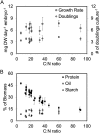Carbon and nitrogen provisions alter the metabolic flux in developing soybean embryos
- PMID: 23314943
- PMCID: PMC3585609
- DOI: 10.1104/pp.112.203299
Carbon and nitrogen provisions alter the metabolic flux in developing soybean embryos
Abstract
Soybean (Glycine max) seeds store significant amounts of their biomass as protein, levels of which reflect the carbon and nitrogen received by the developing embryo. The relationship between carbon and nitrogen supply during filling and seed composition was examined through a series of embryo-culturing experiments. Three distinct ratios of carbon to nitrogen supply were further explored through metabolic flux analysis. Labeling experiments utilizing [U-(13)C5]glutamine, [U-(13)C4]asparagine, and [1,2-(13)C2]glucose were performed to assess embryo metabolism under altered feeding conditions and to create corresponding flux maps. Additionally, [U-(14)C12]sucrose, [U-(14)C6]glucose, [U-(14)C5]glutamine, and [U-(14)C4]asparagine were used to monitor differences in carbon allocation. The analyses revealed that: (1) protein concentration as a percentage of total soybean embryo biomass coincided with the carbon-to-nitrogen ratio; (2) altered nitrogen supply did not dramatically impact relative amino acid or storage protein subunit profiles; and (3) glutamine supply contributed 10% to 23% of the carbon for biomass production, including 9% to 19% of carbon to fatty acid biosynthesis and 32% to 46% of carbon to amino acids. Seed metabolism accommodated different levels of protein biosynthesis while maintaining a consistent rate of dry weight accumulation. Flux through ATP-citrate lyase, combined with malic enzyme activity, contributed significantly to acetyl-coenzyme A production. These fluxes changed with plastidic pyruvate kinase to maintain a supply of pyruvate for amino and fatty acids. The flux maps were independently validated by nitrogen balancing and highlight the robustness of primary metabolism.
Figures








Similar articles
-
The role of light in soybean seed filling metabolism.Plant J. 2009 Apr;58(2):220-34. doi: 10.1111/j.1365-313X.2008.03771.x. Epub 2008 Dec 10. Plant J. 2009. PMID: 19077167
-
Influence of carbon to nitrogen ratios on soybean somatic embryo (cv. Jack) growth and composition.J Exp Bot. 2013 Jul;64(10):2985-95. doi: 10.1093/jxb/ert138. Epub 2013 Jun 5. J Exp Bot. 2013. PMID: 23740932 Free PMC article.
-
Probing in vivo metabolism by stable isotope labeling of storage lipids and proteins in developing Brassica napus embryos.Plant Physiol. 2002 Sep;130(1):347-61. doi: 10.1104/pp.004275. Plant Physiol. 2002. PMID: 12226514 Free PMC article.
-
Analysing central metabolism in ultra-high resolution: At the crossroads of carbon and nitrogen.Mol Metab. 2020 Mar;33:38-47. doi: 10.1016/j.molmet.2019.12.002. Epub 2019 Dec 19. Mol Metab. 2020. PMID: 31928927 Free PMC article. Review.
-
The use of stable isotopes in the study of human pathophysiology.Int J Biochem Cell Biol. 2017 Dec;93:102-109. doi: 10.1016/j.biocel.2017.07.012. Epub 2017 Jul 20. Int J Biochem Cell Biol. 2017. PMID: 28736244 Review.
Cited by
-
Suppression of SDP1 Improves Soybean Seed Composition by Increasing Oil and Reducing Undigestible Oligosaccharides.Front Plant Sci. 2022 Mar 23;13:863254. doi: 10.3389/fpls.2022.863254. eCollection 2022. Front Plant Sci. 2022. PMID: 35401590 Free PMC article.
-
Identification and Candidate Gene Evaluation of a Large Fast Neutron-Induced Deletion Associated with a High-Oil Phenotype in Soybean Seeds.Genes (Basel). 2024 Jul 8;15(7):892. doi: 10.3390/genes15070892. Genes (Basel). 2024. PMID: 39062671 Free PMC article.
-
Differential metabolic reprogramming in developing soybean embryos in response to nutritional conditions and abscisic acid.Plant Mol Biol. 2023 Oct;113(1-3):89-103. doi: 10.1007/s11103-023-01377-x. Epub 2023 Sep 13. Plant Mol Biol. 2023. PMID: 37702897
-
Differential gene expression provides leads to environmentally regulated soybean seed protein content.Front Plant Sci. 2023 Sep 18;14:1260393. doi: 10.3389/fpls.2023.1260393. eCollection 2023. Front Plant Sci. 2023. PMID: 37790790 Free PMC article.
-
Transcript abundance on its own cannot be used to infer fluxes in central metabolism.Front Plant Sci. 2014 Nov 28;5:668. doi: 10.3389/fpls.2014.00668. eCollection 2014. Front Plant Sci. 2014. PMID: 25506350 Free PMC article.
References
-
- Adams CA, Broman TH, Rinne RW. (1982) Use of [3,4-C]glucose to assess in vivo competition for phosphoenolpyruvate between phosphoenolpyruvate carboxylase and pyruvate kinase in developing soybean seeds. Plant Cell Physiol 23: 959–965
-
- Adams CA, Rinne RW. (1981) Interactions of phosphoenolpyruvate carboxylase and pyruvic kinase in developing soybean seeds. Plant Cell Physiol 22: 1011–1021
-
- Allen DK, Libourel IGL, Shachar-Hill Y. (2009a) Metabolic flux analysis in plants: coping with complexity. Plant Cell Environ 32: 1241–1257 - PubMed
-
- Allen DK, Ohlrogge JB, Shachar-Hill Y. (2009b) The role of light in soybean seed filling metabolism. Plant J 58: 220–234 - PubMed
Publication types
MeSH terms
Substances
LinkOut - more resources
Full Text Sources
Other Literature Sources
Miscellaneous

